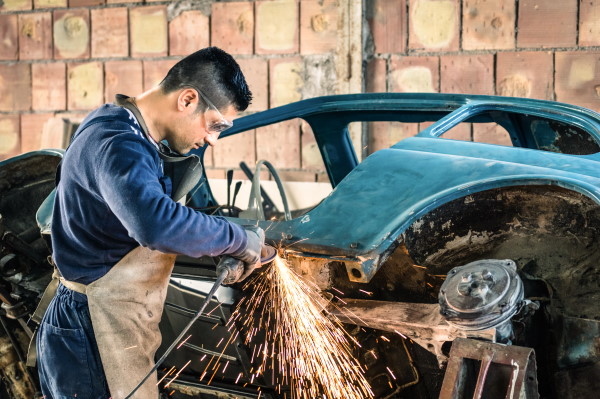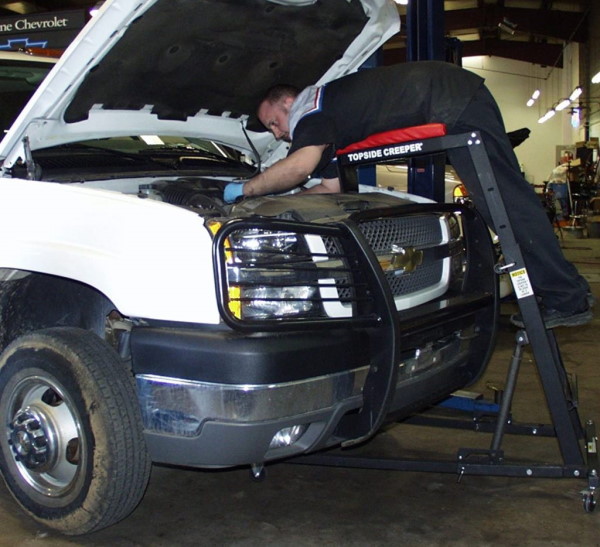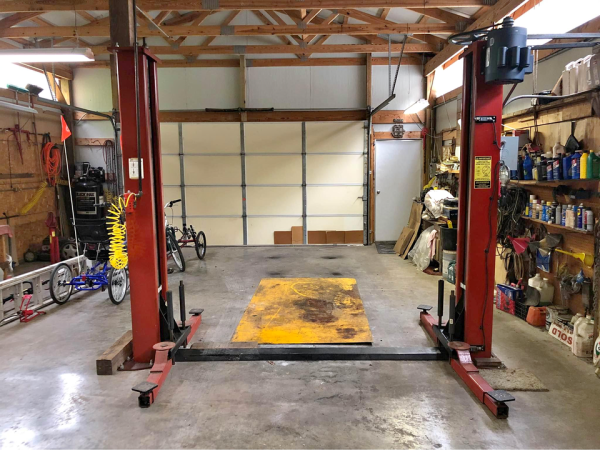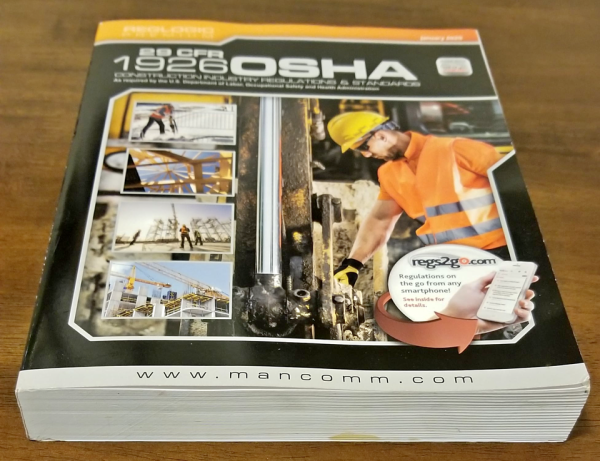Mechanics work a physically demanding job. They stand on concrete all day, work around heavy equipment and are exposed to toxic solvents on a continual basis. Auto mechanics are more likely than the average worker to be injured on the job.

Many vehicle components are under extreme pressure and explosions are not uncommon. According to the Bureau of Labor auto mechanic injury Statistics, work-related injuries to automotive technicians occur at a 1.8 incident rate per 100 workers.
Thankfully, this is on the lower end. Carpet cleaners have a 3.6 incident rate and framing contractors have a rate of 6.8.
Here we break down the most common mechanic injury types, and how you can keep yourself safe on the job.
Had a close call at work? Use the comment box below to share your story.
Here are the most common workplace injuries suffered by auto mechanics. Thankfully, the most common injury is going to be a sprain or a scrape.
Sprains, Strains and Tears

The leading cause of auto mechanic injuries is overexertion injuries such as tears, strains, and sprains. The job requires the constant lifting of heavy objects. The job also requires working at odd angles under the hood or around the chassis.
We all know someone with recurring back pain from an injury they suffered on the job. This classification may not seem serious, however, the long-lasting effects of these injuries can lead to a higher need for painkiller use and physical rehabilitation costs.
Many shops are starting “stretch and flex” programs at the start of the shift. While these activities can appear silly, they may reduce the number of injuries that are reported.
What can be even more effective are investments in tools and policies to protect your employees. Topside creepers provide more ergonomic access to the engine bay. Reducing time pressures and allowing more breaks can keep employees fresh and focused and provide measurable improvement in workplace safety.
Eye Injuries
According to the National Institute for Occupational Safety and Health (NIOSH), 2,000 workers a day experience eye injuries. What’s worse, is that up to 90% of these injuries are preventable.
Eye damage can be caused by power tools. For example, an angle grinder generates a large number of sparks that can be harmful to the eye. Even non-powered tools can be extremely dangerous to an eye. Simple tools like a screwdriver can slip and impale an eye (especially if it is being used as a prying tool).
The first step to preventing eye injuries is wearing safety goggles or impact-resistant safety glasses. Additionally, only using tools for their intended use can further prevent workplace accidents that endanger the eye.
Fatal Injuries

According to a 2007 report by the Bureau of Labor Statistics, 147 mechanics were killed on the job between the years of 2003 to 2005. This puts the average risk of a fatal accident around 4.0 per 100,000 employees.
However, the mechanism of death sheds some surprisingly light on how mechanics are most likely to die. 31.3% of the deaths were caused by “assaults and violent acts”. 55.8% of those were self-inflicted.
The other major category is contact with vehicles or automobile parts, which caused 44% of the deaths. These are mostly grouped into two categories of a vehicle falling during transport or falling off of the stand or while being jacked. (One reason why jack stands are such a vital piece of safety equipment).
Overall, being a mechanic is the 14th most dangerous job when both fatal and non-fatal injuries are accounted for. It is important that m
Chemical Burns
Auto mechanics deal with a large number of solvents. They risk injury from both direct contact and from breathing the fumes.
All solvents are dangerous. Benzene, toluene and xylene, are some of the common solvents used in an automotive shop. They have been linked to hematological distortions such as a reduced white blood cell count and compromised immune systems.
Asbestos continues to be used in brake pads, and the dust could provide dangerous exposure to mechanics. Studies have shown that mechanics have a slightly higher risk of lung cancer, but that may be more a result of smoking than from asbestos exposure.
Exhaust fumes can also create an asthmatic response. Fumes also have a high level of Carbon Monoxide, which can be deadly.
Maintaining good ventilation at all times is required to avoid chemical injury, even if this means compromising the comfort of the employees. Additionally, mechanics must wear gloves when working with solvents.
It is common for mechanics to shrug off these risks. It is important for the shop foreman to ensure that all safety protocols are being followed.
Loss Of Limb

Loss of limb is not as common as some of the other injuries and is often newsworthy. The loss of a limb is always a traumatic experience. Using cutting tools such as metal shears and angle cutters can cause a higher risk of losing a limb. Heavy objects falling on a limb can also cause an amputation.
Getting caught by spinning equipment and being pulled into the machine can also cause loss of limb. This is why it is important to not wear loose clothing when working on cars. Tying back long hair and removing jewelry can also help reduce risks.
Prevention can be helped by steel toe boots, and in teaming up with another mechanic when working with heavy objects or dangerous cutting tools.
Slips Trips And Falls
An automotive shop floor is frequently covered by oil residue, grease and antifreeze. These provide a slick surface that is dangerous to walk on. Even after a surface has been cleaned, a small film may remain.
Tools and air hoses are often left laying on the floor, which can cause a trip hazard. Having designated storage areas for all tools and investing in air hose reels can help prevent these trip hazards.
It is important that all staff know how to clean up a spill and that they work together to create a safe walking environment. Additionally, slip-resistant shoes can help prevent slip and falls. Rubber mats for standing can also provide an anti-skid environment.
This is one reason why most automotive shops do not allow customers to walk into the engine bay area.
Repetitive Use Injuries
When you make the same motions repeatedly, it can cause inflammation in a repetitive use injury. These injuries can slowly escalate to the point that the mechanic has to take time off of work.
Some common repetitive use injuries for automotive mechanics might include carpal tunnel syndrome, tennis elbow and lower back pain from repeatedly lifting heavy objects.
Taking frequent breaks to stretch the fingers and related muscles can help create relief. Ergonomic tools can also help reduce these injuries.
Automotive Workplace Safety

According to the Bureau of Labor Statistics, auto mechanics are more likely to lose time to occupational injuries.
These injured mechanics decrease productivity, lower morale and create higher workers compensation insurance premiums.
In some cases, an employee may even sue their employer, creating added legal fees.
It is imperative that workplace safety be the priority. Adequate training from an approved Occupational Safety and Health Administration (OSHA) provider should be required. The 10-hour General Industry course is an excellent start.
Shop managers should maintain a high standard of enforcing safety requirements on all employees.
Workers Compensation Benefits
Workers compensation benefits help provide coverage for medical treatment, rehabilitation, disability, and restitution for an injured worker. The standards are set by the Department of Labor, and the insurance is purchased by the employer from private insurance companies.
This insurance also protects the owner by reducing the amount they have to pay directly. In some cases, having insurance can also reduce the risks of lawsuits and lawyer fees.
Considering that the average settlement for a back injury workers compensation claim is around $20,000, it makes sense to both prevent injuries and to insure against potential claims.
Do Auto Mechanics Get Injured Often?
Being a mechanic is the 14th most dangerous job in America. On average, 4 out of 100,000 mechanics will die on the job in a given year. 166.8 out of 10,000 mechanics will suffer a non-fatal injury in any given year.
Is Being A Mechanic Hard On Your Body?
Being a mechanic is a physically more demanding career than working an office job. It requires standing for long hours and working around heavier equipment.
While it is an extremely enjoyable job, it does tend to lead to more long-term injuries. Most mechanics have long careers, working well into their 60s. This career does not seem to have a much shorter lifespan than other careers.
What Is The Most Common Injury In The Automotive Industry?
The most common injury is in the category of “sprains and strains” (39%). This can include things such as back pain from straining to lift heavier objects and other musculoskeletal injuries.
The next two categories of common injuries are lacerations (22%) and contusions (15%).
What Health Problems Do Mechanics Have?
The most long-lasting health effects can come from exposure to solvents, lead and asbestos. Additionally, it is common for a mechanic to suffer long-term back pain from a 1-time acute injury. If symptoms are not resolving, it may be worth retaining the counsel of a workers compensation attorney.
It is important that injured workers are reported in a timely fashion. Most states have deadlines on when to file claims. In many cases, employers need to be informed within 45 days, and claims need to be filed within 3 years.
 Skip to content
Skip to content

